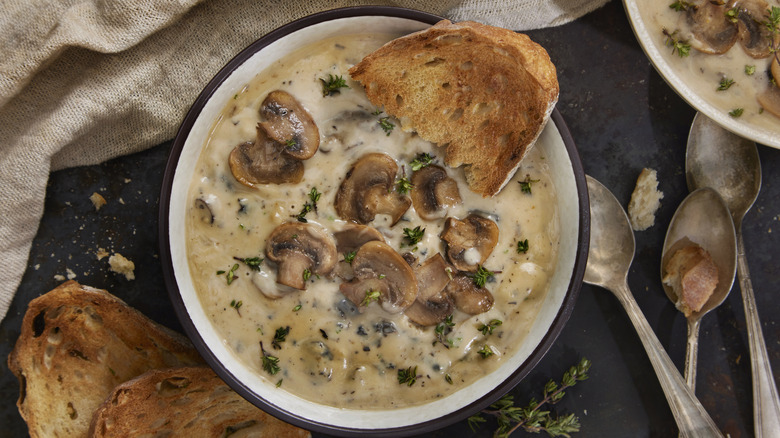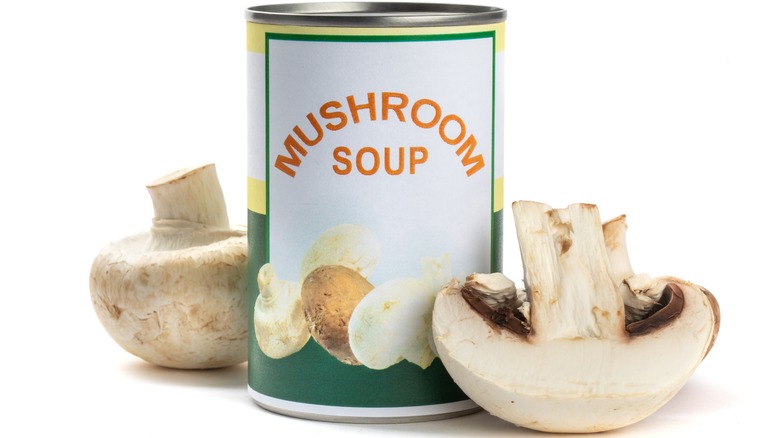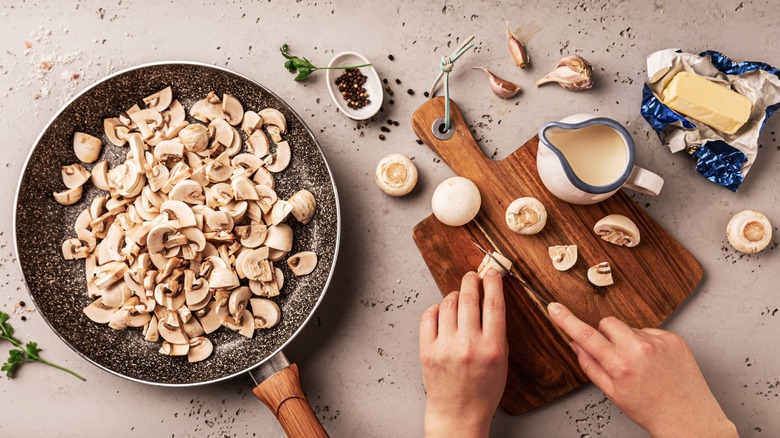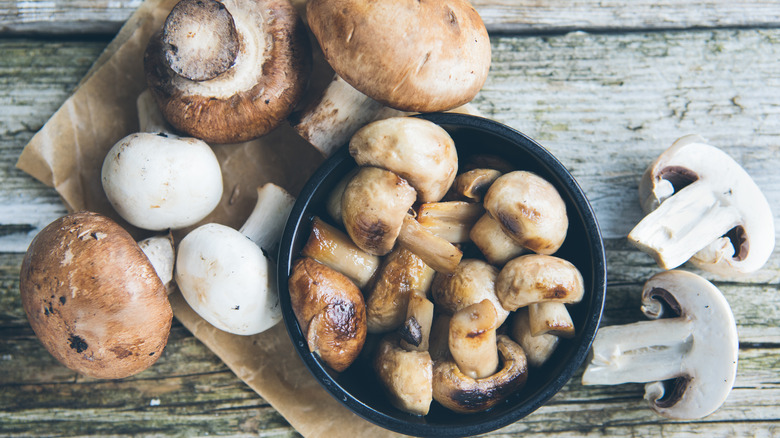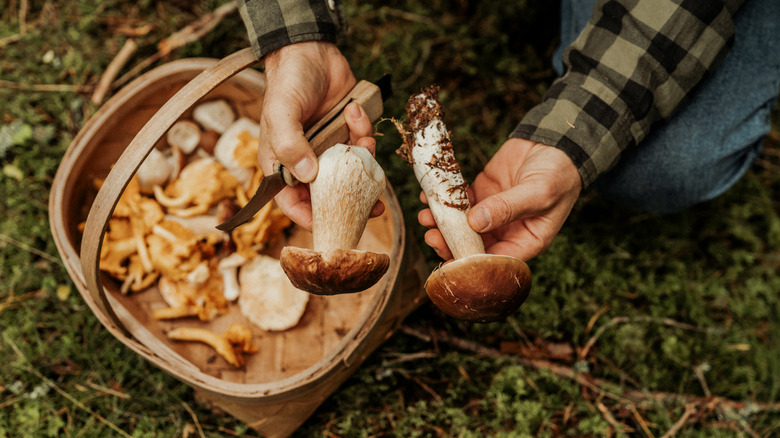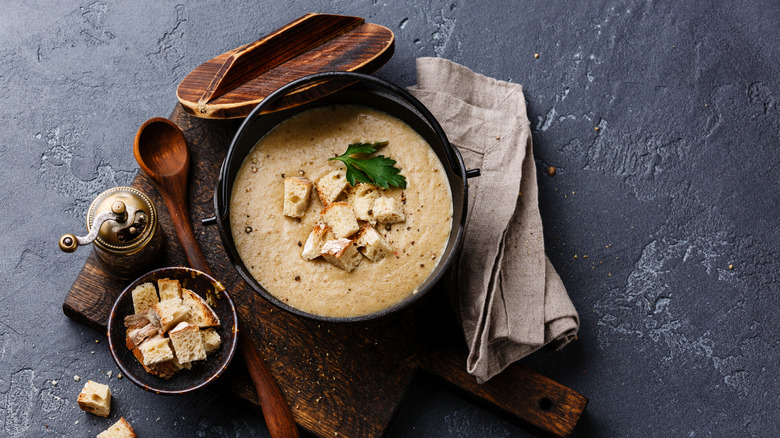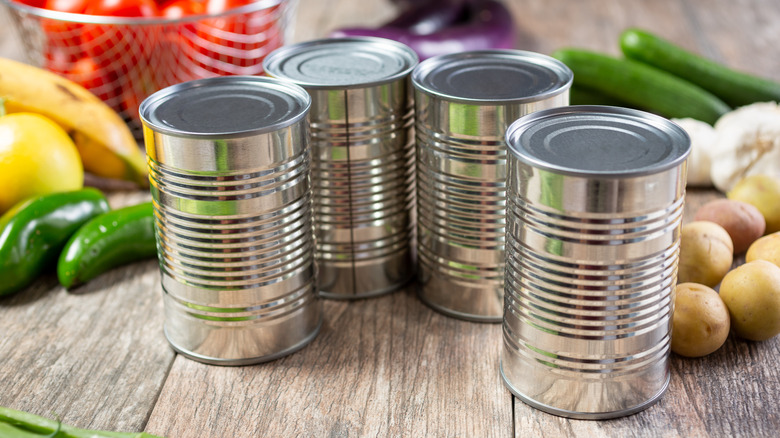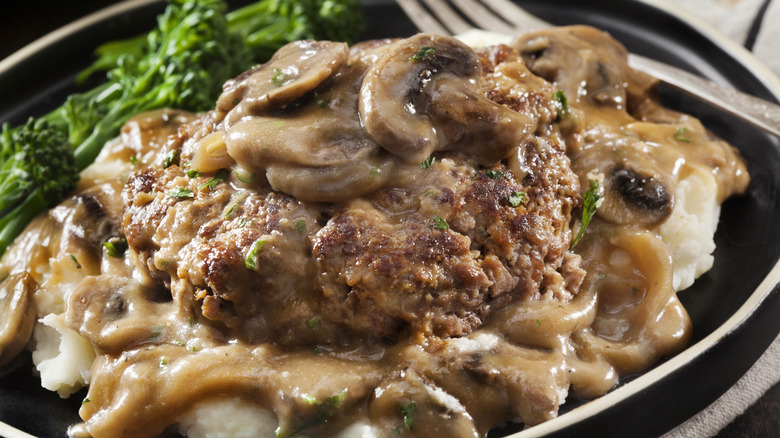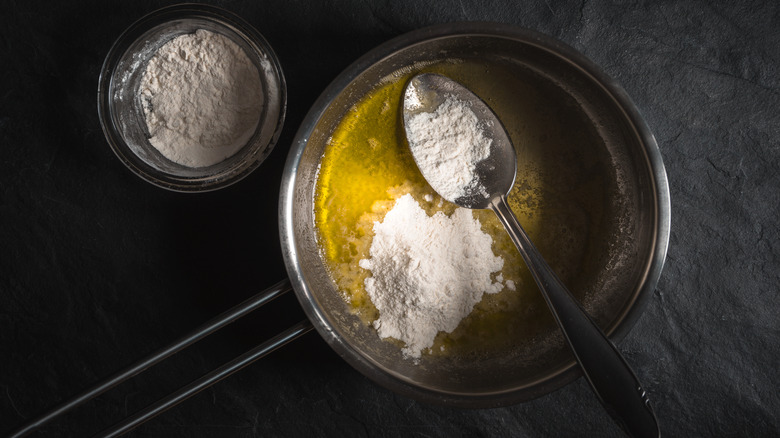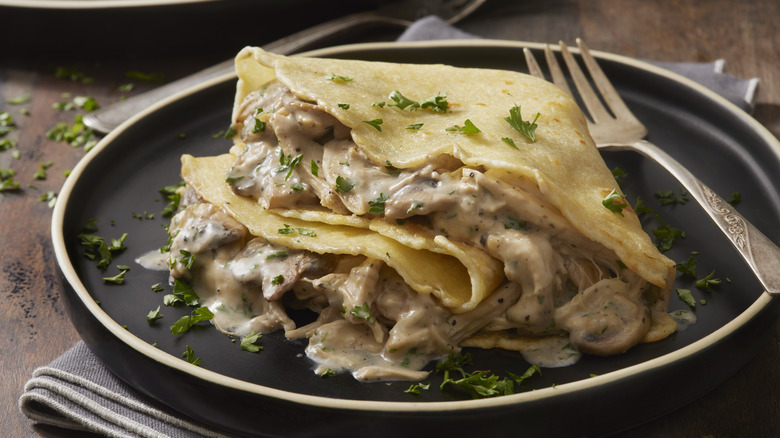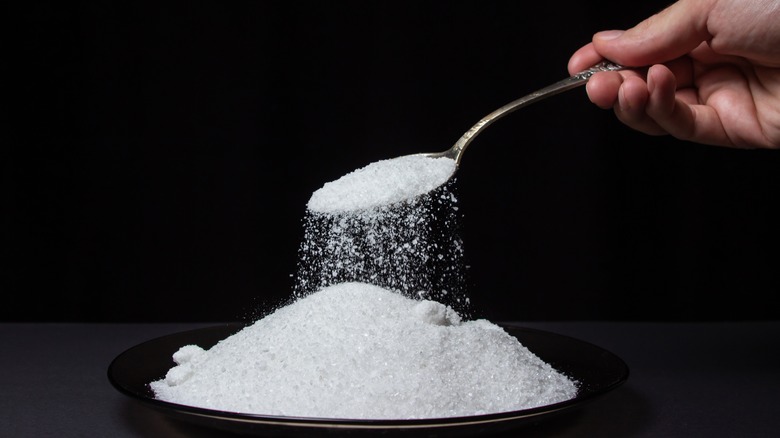Stop Making These Mistakes When Cooking With Cream Of Mushroom Soup
Cream of mushroom soup has become a staple of the home chef, not only due to its standalone strength as a soup, but also its potential to create other delicious dishes. Those who like experimenting in the kitchen can come up with some unexpected winners when subbing in this soup or mixing in your own flavors. It's a pretty simple soup to make even for beginners in the kitchen, but there are still plenty of mistakes you can make when cooking with cream of mushroom soup.
Mushrooms are a phenomenal source of nutrients, like antioxidants and magnesium, that help keep your body in tiptop shape, and they are great for boosting your immune system too. They can do a lot of good in the body, which is why they deserve the respect of a decent dish. Whether you're preparing the soup from a can or channeling your inner chef to create a homemade recipe, here are some things to watch out for and tips for upgrading cream of mushroom soup.
Limiting yourself to just soups or casseroles
Cream of mushroom is a killer soup for mushroom lovers, sure, but the possibilities go so much further than just soup. This variety of canned soup is a well-known base for a slew of casseroles, too, from a hamburger potato casserole to a Nixon chicken casserole. However, home chefs have been known to craft other creative meals without the use of their casserole dishes. Pastas, savory sauces, steak toppings, and even some unexpected sides have been the brain children of cooks with a love for cream of mushroom soup.
One strength of cream of mushroom soup is that it makes a good replacement ingredient, particularly when thinking outside of the box. Chicken pot pie, for example, becomes a more complex comfort food when using cream of mushroom soup in place of the typical gravy base. When added with a bit of milk, the soup can act as a base for practically any creamy pasta, as it provides a similar texture while adding that signature mushroom flavor.
A great way to be the talk of a potluck is to bring a revamped side dish. You can take a classic side like sweet mashed potatoes, rice, or creamed spinach and give it a special twist by adding cream of mushroom soup. Another alternative to grabbing your casserole dish is to plug in your crock pot. Slow-cooking meat like chicken or beef in the soup will keep it tender and infuse it with flavor.
Forgetting to spice up your soup
Any chefs worth their salt use more than just, well, salt. Adding a range of herbs and spices will elevate any meal. Parsley, tarragon, sage, and oregano all pair nicely with a mushroom flavor. Paprika and allspice along with cinnamon are interesting complements to mushrooms' umami flavor as well. However, you can look further than your spice rack for ways to transform your plain cream of mushroom soup into a marvel of a meal.
Most things are better with cheese, and cream of mushroom soup is no different. Generously sprinkle some of your favorite cheeses over a simmering pot of cream of mushroom soup to create a thicker and cheesier soup akin to a cheddar and broccoli. Look toward other dairy additions, like butter or condensed milk, to bring more flavor to your soup.
Consider what you're serving alongside your soup to determine what you should add to it. While a rich dairy product may often do the trick, wine can also liven up cream of mushroom soup. White wine can transform your dish into a refreshing and balanced meal, while a splash of red wine may give your soup more depth. Simply serving cream of mushroom soup means a limitless amount of missed opportunities. Consider spicing your dish up with something — your taste buds will thank you.
Always opting for the cheapest soup option
We get it. You're dining on a budget, and cream of mushroom soup can certainly fill your belly without emptying your wallet. When you're paying for groceries in loose change recovered from the depths of your couch, a bargain brand is better. If you can spend an extra dollar or two on a premium soup, though, it can really pay off in terms of flavor and texture.
Sometimes it really is cheaper to buy canned goods over fresh ingredients that you cook up from scratch. While a pack of mushrooms by themselves can cost upwards of $4, a can of soup for less than a dollar sounds pretty great. You still may be able to stick within your budget at $4 can, though. Remember, most cans contain more than one serving, so your per-meal cost is at least cut in half.
When you buy budget brands, the ingredients going into your body are typically going to be lower quality. When you look at the ingredients for Kroger brand cream of mushroom soup, you'll see some identifiable ingredients and some wildcards, like titanium dioxide, which is used for color. When you look at an Amy's brand soup, though, all the ingredients are clearly stated and identified as organic. Both taste and nutrient levels increase as higher quality ingredients are used, which also typically coincides with an increased price.
Never making your own own cream of mushroom soup
Canned foods are typically affordable and convenient, but breaking out the knife and cutting board to make your own soup really pays off in the flavor department. Creating a meal from scratch is not only personally and emotionally satisfying, but it also exercises your creativity and cooking talent. Actively making your own food can have health benefits as well because you know exactly what is going into your food, and you can make it to your own particular liking. The only person who can make the perfect personalized cream of mushroom soup for you is you, so don't always default to premade options.
Even if you splurge on the more pricey cans of cream of mushroom soup, you are still dining on heavily processed foods. Canned soup maintains some of the nutritional value from its ingredients, but using fresh ingredients ensures nutrients without many added preservatives. Canned food will have added salt, and some brands of cream of mushroom soup may have unwanted ingredients like monosodium glutamate (MSG) or soy that homemade versions will lack.
Other than the taste and health benefits, cooking cream of mushroom soup from scratch also comes with the unique benefit of self reliance (just don't skimp on the heavy cream). There's nothing quite like the thrill of being able to say that you have a homemade dish. After perfecting your recipe, you may never want to buy a can of soup again.
Neglecting to add real mushrooms
One of simplest and most obvious ways to take cream of mushroom soup up a level may actually be one you haven't yet considered. Adding real, fresh mushrooms to your premade soup will not only boost the flavor and quality but also bring a little extra love and personal touch in whatever dish you are preparing with it.
If you're worried that adding more mushrooms to an already mostly mushroom soup will be overkill, we promise it's not. Adding fresh mushrooms into the mix will add texture as well as an appealing presentation. For home cooks who want to really up the wow factor, using several different types of mushrooms can turn a run-of-the-mill soup into the ultimate mushroom dish. Button mushrooms, morels, or oyster mushrooms are all great choices, and you can even throw in a few dried mushrooms.
One key factor to consider when adding fresh mushrooms to a standard cream of mushroom soup is how you prepare those mushrooms. You're not going to want to add in raw mushrooms. You want browned or sautéed mushrooms that you've cooked in a separate pan. With generous seasoning, the mushrooms will be the star of the soup, and you'll wonder how you ever ate cream of mushroom soup without the modification.
Not cooking for the season
Mushroom is a classic fall flavor, but autumn is not the only time you could, or should, eat this fungi. Cooking and eating for the season entails using only produce that is in season, and the practice comes with some pretty spectacular benefits. Seasonal eating is important because it helps you become one with nature, and eating what the earth provides when it provides it is actually better for the environment. In-season food should also taste better as it is more fresh and has ripened along its natural life cycle. It also typically contains fewer added ingredients for inducing growth.
The harvest seasons for mushroom foraging are typically in the spring and fall, but farm-grown mushrooms are in season year round. With mushrooms being available almost all the time, it is typically the pairings they are served with that determine a mushroom-centric dish's seasonality. Try a mushroom and asparagus casserole in the spring, an artichoke mushroom dip in the summer, and a creamy mushroom-topped sweet potato in the winter.
It's relatively easy to eat seasonally. Research which produce is harvested in each season, and stick to a menu surrounded by those foods. Shopping at a farmer's market is a great way to support your local farmers and take advantage of fresh, in-season fruits and vegetables. Chances are, you'll be able to find a mushroom vendor there as well!
Wasting leftovers
Sometimes you really don't need the whole can of soup, but is saving what's left over ever actually worth it? When it comes to cream of mushroom soup, the answer is absolutely! Ditching your unused cream of mushroom soup is a culinary crime. Even a spoonful or two of this useful soup can be added to recipes to elevate them, so stashing a bit in your fridge could come in handy. Pro tip: Freeze the soup in portion trays to easily use smaller amounts at a time.
If you've been crafting in your kitchen and have a large amount of leftover homemade cream of mushroom soup and you're deciding whether to store it or pour it down the drain, never fear! While the freezer is a great place to store leftovers if you have the room, cream of mushroom soup can also be dehydrated for compact storage. While soup will last up to three months in your freezer, dehydrating it will keep it sitting happily on your cupboard shelves for decades if stored properly. Then, you're free to rehydrate your dried food at your leisure. And don't worry, you'll likely find plenty of use for your cream of mushroom soup before it's old enough to legally drive.
Using an expired or dented can of soup
One of the biggest appeals of canned food is that it has quite a long shelf life. A can of cream of mushroom soup on store shelves typically has a "best buy" date set for around three years after purchase. After this date, it is still considered good to eat for up to a year or more.
While this may be okay in a pinch, we do not particularly recommend relying on the soup for a top-tier meal once it has expired. If you're using that lost can of cream of mushroom soup past its expiration date, you'll likely notice a drop in quality and taste. If you're using the soup as an ingredient, an expired soup could bring the entire dish down with it.
Other than an — albeit loose — expiration date, you should be looking out for any dents or damage to the can. Unlike the "best by" date, a dent could come with serious repercussions. A significant dent, like one with sharp edges, can mean the food inside has been compromised. A can that has allowed bacteria inside runs the risk of making those who eat it very sick. Even the smallest taste of contaminated food can pass along botulism, which can be fatal. You should not be eating food from a dented can or a can that has a lot of rust or visible damage.
Underestimating cream of mushroom soup's versatility
One of cream of mushroom soup's strongest traits is its versatility in complementing different flavor profiles. It is an adaptable ingredient, so it can be paired with a range of proteins, from beef to shellfish. Don't underestimate what cream of mushroom soup can do because if you do, you'll be severely limiting your culinary world.
Mushrooms pair incredibly well with beef and chicken. Combining the soup with either protein is simple to execute in an impressive way. Beef and mushrooms are both hearty ingredients, but cream of mushroom soup is light enough to not overpower a beef dish. With chicken being a lighter protein, the meatier flavor of the mushroom gives a meal a certain balance. Including them side-by-side in a dish is a great way to create a complementary meal while sneaking in a serving of veggies. Whether you're topping off a burger, steak, or chicken breast, a cream-of-mushroom-based sauce will kick up the flavor. Pro tip: Add some fresh, sautéed mushrooms for a more substantial topping.
Cream of mushroom soup can go with so many more flavors, especially if you're an adventurous cook. Pork and even seafood can work well with the soup base. A cream of mushroom sauce completely changes the flavor of an otherwise textbook shrimp fettuccine Alfredo, pork chop, or oyster stew.
Cooking cream of mushroom soup without reaching the desired thickness for a dish
Cream of mushroom soup may have a chameleon-like nature, but that doesn't mean you shouldn't put in a little work to make it an effective ingredient. Straight out of the can, cream of mushroom soup tends to be either quite thin or, if from concentrate, thick and gloopy. For some recipes, you will need to thicken the ingredient up. For others, you may have to dilute it further.
If you are simply making a soup or a thinner sauce, typically you would dilute a canned concentrate. It does matter what you dilute the soup with, though. Most cans call for milk or water, which you can add at the beginning of the cooking process. However, some like to dilute it with cream instead. Since cream is more rich in fat content, you will need to add the cream near the end of the cooking process so it does not separate.
Alternatively, you can thicken the soup with a roux. A roux is made by heating butter and gradually adding flour until it has a gravy-like texture. Instead of making a roux, some home cooks like to simply keep a concentrated soup undiluted when using it as an ingredient. From here, it's easy to add small amounts of sour cream or yogurt to modify the texture to your desired thickness.
Overlooking breakfast with cream of mushroom soup
If you've never broken out that can of cream of mushroom before noon, it's time to open your mind to a whole new world of meal options. Starting your day with a can of cream of mushroom soup can lead to one bangin' breakfast, and it really doesn't take much extra effort at all.
This early-morning matchup is mostly made possible thanks to eggs. Eggs pair well with cream of mushroom soup, and there are a lot of ways to involve the two with each other. The simplest is to add a couple of tablespoons of the soup when making scrambled eggs. More laborious versions of the egg and mushroom pairing include a creamy mushroom frittata or an oozing veggie omelet.
Eggs not your thing? Fans of a down-home breakfast can substitute a thickened cream of mushroom soup for gravy and pour a scoop over a pair of freshly baked biscuits. Funeral potatoes, or a hash brown casserole, can also be made with the soup and eaten for breakfast.
Choosing the regular sodium option
Generally speaking, we consume too much sodium. According to the dietary guidelines from the U.S. Food and Drug Administration, adults should limit their sodium intake to less than 2,300 milligrams a day. However, average actual intake is around 3,400 milligrams. While sodium is a vital nutrient that keeps our bodies running as they should, too much can really bog down our kidneys.
One of the biggest culprits in this copious sodium epidemic is soups — we're looking at you, cream of mushroom! Luckily, most brands do offer a low-sodium option. For example, the sodium content in a can of regular Campbell's cream of mushroom soup is 410 milligrams per serving, or 1,025 milligrams per can. Campbell's also offers a can with 25% less sodium and another labeled unsalted, which knocks down the sodium content to 50 milligrams per serving.
When searching for soup that will help you lower your sodium intake, be sure to check the nutrition label. Verbiage on a label can be incredibly misleading. If a brand is using the terms "less sodium" or "reduced sodium" to advertise its product, this doesn't necessarily mean there is a low amount present. These terms just mean that the can in question has less sodium than the brand's regular variation of cream of mushroom soup.
